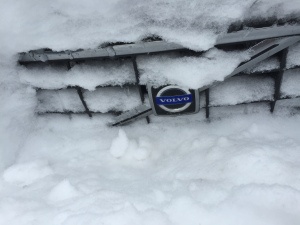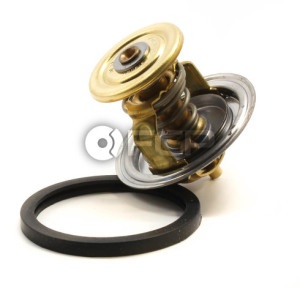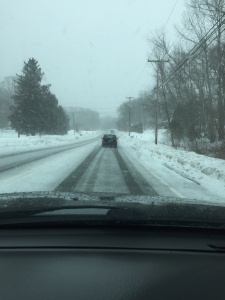It seems the snow and cold fronts in the last few weeks have changed what had been a mild winter. Here are a few tips and reminders for drivers to help you finish out the season.
To let warm up? Or not to warm up? That is the question...
 This concept of "warming up" often refers to car owners starting their vehicle and letting it idle for a period of time (I've seen some leave them on as long as 20min before driving away!). This is something that I do not do. Its not that it is necessarily bad for the car, thats debatable, but rather most do it so they can go right from their toasty warm home or office into an equally toasty car before driving off. For that reason, I see "warming up" a vehicle as more of a waste of fuel and putting the vehicle through an unnecessary time at idle. If it is the car you are concerned about getting to operating temperature quickly, then get it, and drive it. In doing so, the engine, transmission, differential, cabin heat, brakes and tires will come more quickly to their optimal temperatures than if the car was to sit on for a period of time. One caveat: take the first few miles easy until the engine has reached normal operating temperature (you can usually tell when the temperature gauge is right in the middle of its range). BMW E46 M3 and E39 M5 owners have a nice feature where there are lights on the tachometer which gradually go away as the engine warms indicating the driver can shift at a higher RPM.
This concept of "warming up" often refers to car owners starting their vehicle and letting it idle for a period of time (I've seen some leave them on as long as 20min before driving away!). This is something that I do not do. Its not that it is necessarily bad for the car, thats debatable, but rather most do it so they can go right from their toasty warm home or office into an equally toasty car before driving off. For that reason, I see "warming up" a vehicle as more of a waste of fuel and putting the vehicle through an unnecessary time at idle. If it is the car you are concerned about getting to operating temperature quickly, then get it, and drive it. In doing so, the engine, transmission, differential, cabin heat, brakes and tires will come more quickly to their optimal temperatures than if the car was to sit on for a period of time. One caveat: take the first few miles easy until the engine has reached normal operating temperature (you can usually tell when the temperature gauge is right in the middle of its range). BMW E46 M3 and E39 M5 owners have a nice feature where there are lights on the tachometer which gradually go away as the engine warms indicating the driver can shift at a higher RPM.
Earlier this winter, my 1998 Volvo S70 would seem to never reach operating temperature and almost seemed "stuck" at the 1/3 mark no matter how long I drove. Occasionally it would reach the half way mark after 45 or so min on the highway but seldom in my day-to-day driving did I drive that long on the highway. The problem seemed to be with the thermostat. If you're experiencing a similar issue, or if your car is taking too long to heat up, consider replacing the thermostat. Its about a $20 part and takes all of 20min to change on the P80 Volvos. Now that I have changed mine, the cabin seems to heat up faster as well and the cars coolant temperature is where it is expected.
Do I need snow tires if I have all seasons?
Think of tires like this:
Snow Tires: Heavy Duty Snow Boots
All-Season Tires: Hiking Shoes/Trail Running Shoes (i.e. Merrell Moabs)
Summer/Performance Tires: Running Sneakers
Consider this, your tires are the only thing coming in contact with the road surface regardless of the condition. Just as you wear snow boots to minimize your chances slipping when walking outside, you should consider doing the same for your car for the exact same reason! The answer would be to mount a set of snow tires. Their rubber compound and tread differs to that of summer/performance tires and even all seasons; optimized to release snow from them and increase surface area. Some even come with "studs" in them for even better traction on ice. You can mount these tires on a cheap set of rims (often steel wheels) which as a bonus will save the alloy finish of your other wheels from the salt.
Though the truth is there are a lot of people like myself who simply don't have the budget to purchase a separate set of tires. I currently have a set of Continental all-season tires on my S70. Just as you take extra caution when you're walking in shoes not optimized for snow and ice, you need to take caution driving in such conditions with tires not optimized for the same purpose either.
Not getting stuck
Many of us have morning commutes which often can have us out of the house before the plow truck gets a chance to come around to our street again, or in some cases, at all! This often leads us to have to drive on completely snow covered roads with the odd set of tracks on it from where your neighbor decided to have a play in his lifted Jeep Wrangler. Usually by the end of the day, the side roads have been taken care of to a point where getting stuck does not necessarily pose a threat.
Regardless of how many wheel drive you have, it can sometimes be best to turn OFF the traction control system when needing to go through deeper snow, it may bog the vehicle down. My S70 uses an early ABS based traction control system which will grab at the brakes of the front wheels if they begin to spin and release them at different rates. However, a little wheel spin can sometimes be necessary to allow for you to gain momentum. DO NOT spin the wheels at a high rate of speed (>60mph) or for too long as you may blow a tire out! Some cars like the Land Rover models with Terrain Response automatically make the traction control less sensitive when certain driving modes are selected.
Another tip for not getting stuck is using a light foot on the gas pedal! If you already have traction going up a snow-covered hill with light throttle, giving it more can cause the wheels to spin which will make it harder to re-gain traction. Use your throttle pedal by feeling when the car has grip and try to stay at that threshold. If the wheels start to slip back off and re-apply slowly.
Those tracks that your neighbor created in his Jeep? Those are your friends! The snow where these track are have been packed down and can often be a better option than trying to plow your wheels through 8in of fresh snow where they may get bogged down, in turn, getting you stuck.
There is some debate over using the "W" (Winter/Wet) button which the automatic P80 as well as P2 Volvos have. By pressing this button in my S70, the transmission starts in 3rd gear which will effectively makes the throttle much less sensitive to my inputs as it will take more throttle to move the car from standstill in a higher gear. While I feel a well-maintained transmission should not have a problem doing this, I refrain from it. Having light foot as stated above with good throttle modulation is a much better option.
Stopping
ABS or Anti-Lock-Braking-System can help the average driver more easily bring their vehicle to a stop however ABS requires more distance to do so as it is rapidly "pumping" the brakes to prevent them from just locking and sliding along the surface. Give yourself more distance to the car therefore in the event of an emergency the system will have the necessary room to bring you to a stop. Snow tires can also help in bringing down the stopping distance required as they can maintain traction longer before lock-up. Also, remember to keep the wheel straight. Slamming on the brakes on a slippery curve may cause the front wheels to lock easier which will cause understeer and the vehicle will continue straight on as opposed to the intended direction. Try to do your slowing down/braking mostly in a straight line.
Lastly, I'd like to share a quote from my instructor at the Land Rover Off Road Driving School which applies well to winter driving: "As slow as possible, as fast as necessary."
About the Author: Noah Jenkins
 Noah Jenkins is attending the University of Connecticut studying Electrical Engineering. He’s been around Volvos since birth and currently drives and maintains a 1998 S70. His knowledge and interest in European vehicles expands to BMW, Audi, and Land Rover as well.
Noah Jenkins is attending the University of Connecticut studying Electrical Engineering. He’s been around Volvos since birth and currently drives and maintains a 1998 S70. His knowledge and interest in European vehicles expands to BMW, Audi, and Land Rover as well.













